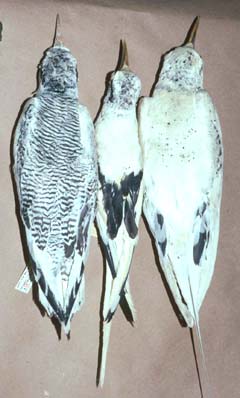
TROPICBIRD IDENTIFICATION by Don RobersonThere are only three species of tropicbirds around the world, and all are shown in the following gallery of four shots (all photographs on this page are © D. Roberson; all rights reserved):
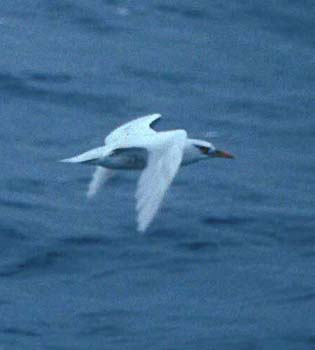
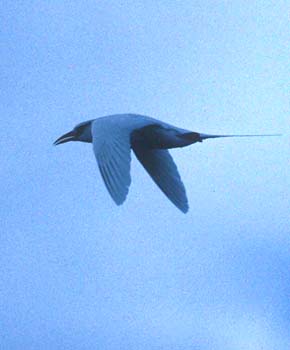


These tropicbirds are, respectively, two Red-tailed Tropicbirds (upper two photos; lefthand bird is quite young and tailless but is out of juvenal plumage), an adult White-tailed Tropicbird (center) and an adult Red-billed Tropicbird (bottom). No matter what age the tropicbird may be, the important i.d. points are these:
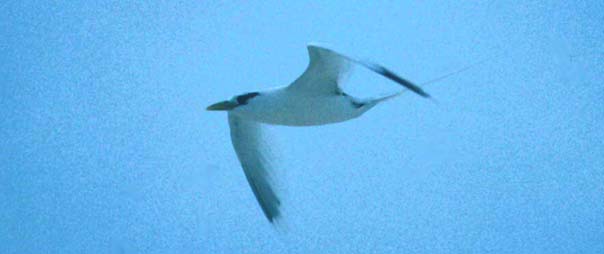

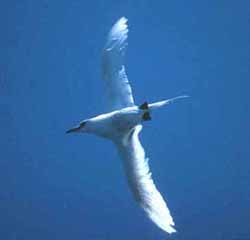 First, even from below, the characteristic wing patterns are visible:
First, even from below, the characteristic wing patterns are visible:
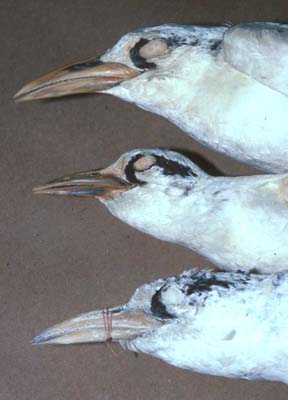
The top bird is Red-tailed with a huge, long, hefty bill [#728906 collected 18 Dec 1900 in e. trop. Pacific at 16°N, 115°W]
The middle bird is White-tailed with a slim and comparatively dainty bill [#217073 collected 8 Feb 1927 in the Solomon Is.]
The bottom bird is Red-billed with an intermediate bill; decidedly larger than White-tailed but not as long and massive as Red-tailed [#776556 collected 10 June 1963 at Jamaica Bay, New York, where it was a vagrant.]
All specimens are of female birds. They are also all in an immature
plumage, as can be seen when the same specimens are laid side by side (below);
all have varying degrees of barring or mottling on the upperparts, especially
around the nape and crown. Red-billed is to the left, White-tailed in the
center, and Red-tailed to the right:

This example is both useful and misleading. The comparison is good because
it does show the relative size of the birds: White-tailed is small, Red-tailed
is huge, and Red-billed is big but a bit smaller than Red-tailed. This
example is poor because the birds shown are in different subadult plumages.
The tailless Red-billed (lefthand bird) is still in juvenal plumage characterized
by the extensive barring from nape to rump and on the upperwing coverts.
The other two birds are older is some stage of sub-adult plumage with tail
streamers growing. Juvenal-plumaged birds of all species are heavily
barred above. Almost nothing has been published about their identification,
and I have been unable to review a sufficient series of specimens to come
to any conclusions, but it does appear that even juvenal birds show characteristic
wing pattern similar to those of the adults. It is said that White-tailed
is more coarsely barred than Red-billed in juvenal plumage (Orta 1992)
but I cannot confirm that. Please note, however, the black-centered tertials
on the big Red-tailed Tropicbird (righthand bird) are conspicuous on this
mostly white bird. This character can be useful in some subadults, but
it can be very hard to see on birds in the field (e.g., the top two photos
on this page). However, even adult Red-tails usually retain a black shaft
streak on the tertials.
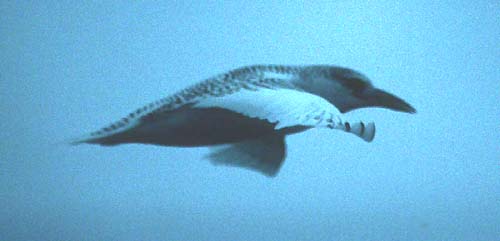
As we have discussed, all juvenal tropicbirds are heavily barred above. A fine example is this Red-tailed Tropicbird photographed off central California: note it is finely barred above from nape through the rump and across the upperwing coverts. This pattern is similar to other juvenal tropicbirds, but this bird is easily identified as a Red-tailed because of its all-white flight feathers (remiges) and because of its disproportionately big bill. You can see the fine black shaft streaks on the outermost primaries but the primaries still look essentially "all-white" and not at all like the primaries of the other two species.
According to Gould et al. (1974), juvenal plumage in Red-tailed Tropicbird is retained for up to 15 months. Unfortunately they do not identify when remex molt begins (primaries are molted from the inner to the outer) but once begun they state that birds molt almost continuously. A second subadult plumage (with spots and vermiculations on an otherwise white birds, perhaps like the specimen shown above) is common over the next 15-16 months. During these months the central tail feathers steadily grow continuously, and bill lightens (from the tip) to yellowish or orange (3rd year) to red (4th year). Individuals do not return to the nesting grounds until four years or older. Adult tropicbirds appear to molt continuously except when actively engaged in nesting (Gould et al. 1974).
Very little has been published on tropicbird identification in juvenal and subadult plumages. Harrison (1983) makes a stab at it but details are in error, including an over-emphasis on the black in the tertials of Red-tailed and illustrating that black as edges to the feathers rather than as dark centers or shaft-streaks (as it is). None of the literature I've seen properly emphasizes the fact that most Red-tailed Tropicbirds encountered far at sea are white-tailed or look "white-tailed." The range of these birds is extensive (Pitman 1986). We have more to learn about these interesting and oh-so-pelagic species.
Photos: All flying White-tailed TropicbirdP.
lepturus photos were taken on Cousin I., Seychelles, in Nov 1992. The
young Red-tailed Tropicbird P. rubricauda
at upper left was taken in the eastern tropical Pacific at 16°N, 148°30'W;
the upper right subadult was at 6°26'N, 142°14'W, and the shot
from below at about 14°N, 145°30'W; the juvenal Red-tailed (last
photo) was offshore San Luis Obispo Co, California, at 34°35'N,122°27'W,
on 19 Aug 1992. The top Red-billed TropicbirdP.
aethereus was in the eastern tropical Pacific at 4°30'S,84°30'W,
and the one photo'd from below was almost on the Equator at 0°30'S,
93°53'W. All photos © D. Roberson; all rights reserved.
Literature cited:
Gould, P. J., W. B. King, and G. A. Sanger. 1974. "Red-tailed Tropicbird" in Pelagic Studies of Seabirds in the Central and Eastern Pacific Ocean. Smithsonian Contrib. Zool. 158.TOPHarrison, P. 1983. Seabirds: An Identification Guide. Houghton Mifflin, Boston.
Orta, J. 1992. Family Phaethontidae (Tropicbirds) in del Hoyo, J., Elliott, A., & Sargatal, J., eds. Handbook of the Birds of the World. Vol. 1. Lynx Edicions, Barcelona.
Pitman, R. L. 1986. Atlas of Seabird Distribution and Relative Abundance in the Eastern Tropical Pacific. NOAA, Nat. Mar. Fish. Serv., Southwest Fisheries Center admin. rpt. LJ-86-02C.
Page created 20-21 Jan 2000